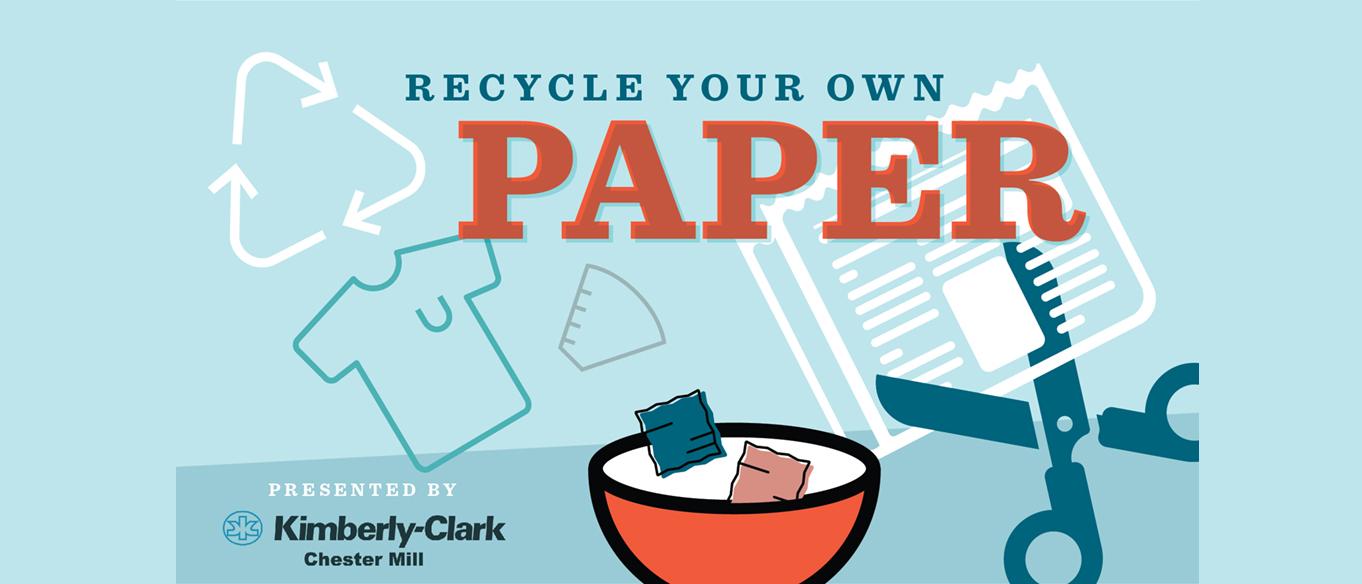
Age: 6+ (Adult help required)
Active Time: 20-30 minutes
Drying Time: 4-6 hours
What you need:
- 5-6 sheets of used, non-glossy paper (like newspaper or old homework papers)
- Scissors
- Medium-sized bowl or container
- Electric blender
- Large rectangular baking dish or sheet pan
- 2 T-shirts* (or similar pieces of fabric) or paper coffee filters
- Sponge or towel
- Water
- Spoon or ladle (optional)
- Hair dryer or clothes iron (optional)
*Ink from the paper could transfer to the T-shirt fabric. Choose dark-colored T-shirts that won’t show any marks, or T-shirts that you don’t mind getting stained.
What to do:
1. Use scissors to cut the paper into small pieces. If you are using a blender for Step 3, ½” x ½” pieces (about the size of a penny) will work well. If you do not have a blender, cut the pieces as small as you can.
2. Put the paper pieces into a bowl or container, and add enough water to cover the paper. Make sure all of the paper is covered with water, and soak for 5 minutes.
3. Ask an adult to help you pour the paper-water mixture into a blender. (If you don’t have a blender, skip to Step 4). Blend until you can’t see individual pieces of paper (about 30 seconds to 1 minute). If the mixture is too thick to blend, add a little more water. This will be your paper pulp.
Things to notice:
- What does the paper look and feel like now?
- How is it different from the way it started?
4. Place one T-shirt into a large rectangular baking dish or sheet pan. Press the T-shirt down to make sure it lies flat against the bottom and covers the entire area of the dish. If you are using coffee filters, cover the bottom of the dish with coffee filters.
5. Carefully remove the blade from the blender. Using your hands, or a spoon or ladle, move some of the pulp onto the T-shirt. Gently spread the pulp into a rectangular shape. Add pulp if needed to make the paper thicker or larger. If your paper is very clumpy and hard to spread, add a little bit of water to make it easier to work with.
6. Gently cover your paper with another T-shirt and press it into the paper.
7. Press a sponge or towel against the top T-shirt to absorb as much water from the paper as you can. Wring out the sponge after every few presses to remove the water.
8. Gently remove the top T-shirt to reveal your paper. The paper is very delicate when wet. Carefully lift the bottom T-shirt with the paper out of the baking dish or sheet pan, and flip the paper onto a dry surface (like a clean countertop, another baking dish or sheet pan, or a plastic cutting board). The T-shirt that was underneath the paper before should now be facing up. Peel this T-shirt carefully off of the paper, and leave the paper to dry for 4-6 hours.
You can use a hair dryer or clothes iron to speed up the drying process. If you decide to use a clothes iron, ask an adult to help you. Be sure to use an ironing board and place an iron-safe piece of cloth over the paper while ironing.
Things to think about:
- Why is it important for the paper to dry before it’s used again?
- How is this recycled paper different from the paper you started with?
- What can you use this recycled paper for?
Cleanup:
Strain out any unused paper pulp from the blender and throw it away, or use it to make more recycled paper. Pour any remaining water down the drain. Wash the T-shirts and dishes that you used.
Explore Further:
- How could you make paper in a different color? Or a different shape?
- How does the recycled paper change if you don’t blend the paper pieces into a pulp first?
- Could you make recycled paper from cardboard, or paper bags, or plant leaves? Try other materials and see what happens!
What’s happening?
Protecting our planet’s resources is an important part of keeping our environment and all the living things in it safe and healthy. That’s why Kimberly-Clark is finding ways to use less water, less energy, and fewer trees in the products they make. Recycling paper fibers to make new paper is one way they—and you!—can conserve our natural resources.
So how does paper recycling work? The paper we use is made out of wood fibers from trees. These wood fibers contain cellulose: a long, sticky, string-like molecule in plants that helps them stay stiff and hold their shape. When paper is cut up and blended with water, the cellulose becomes sticky and helps bind the fibers in the paper together. As the paper dries, those fibers stay glued together and form a new sheet of paper.
Did you notice that the recycled paper you made was less flexible than the paper you started with? Every time paper is recycled, its fibers become shorter and weaker, resulting in stiffer paper. In fact, paper can only be recycled several times before the fibers become too short and weak to form new sheets. In addition to recycling, it’s also important to reduce the amount of paper we use to begin with.
- What are some of the benefits of recycling paper?
- What are some ways that you can reduce the amount of paper that you use?
Presented By

Kimberly-Clark provides essentials for a better life and produces mostly paper based consumer products. The Kimberly-Clark Chester Mill produces Scott 1000 bath tissue and distributes to over 60% of North America! Pulp is turned to finished products and shipped to your local stores from the Scott 1000 factory. You will step through the process from pulping, forming, pressing and drying.

